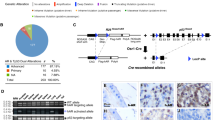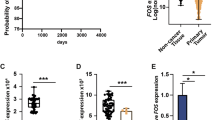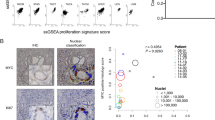Abstract
Replying to: Carver, B. S. et al. Nature 457, 10.1038/nature07738 (2009)
Carver et al.1 question our recent report that mice expressing ETV1 under the control of the probasin promoter (ARR2Pb) develop mouse prostatic intraepithelial neoplasia (mPIN)2. They report the generation of transgenic ARR2Pb-ERG mice with no phenotypic differences from control mice. They propose that this demonstrates that ETS genetic rearrangements do not initiate prostate tumorigenesis and use data from human prostate cancer studies to propose that ETS rearrangements are associated with progression from PIN to prostate cancer. Although we and others have shown that ARR2Pb-ETV1 and ARR2Pb-ERG mice develop mPIN, we have consistently proposed that in human prostate cancer development, ETS rearrangements mediate the transition from PIN to cancer.
This is a preview of subscription content, access via your institution
Access options
Subscribe to this journal
Receive 51 print issues and online access
$199.00 per year
only $3.90 per issue
Buy this article
- Purchase on Springer Link
- Instant access to full article PDF
Prices may be subject to local taxes which are calculated during checkout

Similar content being viewed by others
References
Carver, B. S. et al. ETS rearrangements and prostate cancer initiation. Nature 457 10.1038/nature07738 (2009)
Tomlins, S. A. et al. Distinct classes of chromosomal rearrangements create oncogenic ETS gene fusions in prostate cancer. Nature 448, 595–599 (2007)
Shappell, S. B. et al. Prostate pathology of genetically engineered mice: definitions and classification. The consensus report from the Bar Harbor meeting of the Mouse Models of Human Cancer Consortium Prostate Pathology Committee. Cancer Res. 64, 2270–2305 (2004)
Tomlins, S. A. et al. Role of the TMPRSS2-ERG gene fusion in prostate cancer. Neoplasia 10, 177–188 (2008)
Klezovitch, O. et al. A causal role for ERG in neoplastic transformation of prostate epithelium. Proc. Natl Acad. Sci. USA 105, 2105–2110 (2008)
DeMarzo, A. M., Nelson, W. G., Isaacs, W. B. & Epstein, J. I. Pathological and molecular aspects of prostate cancer. Lancet 361, 955–964 (2003)
Tomlins, S. A. et al. Integrative molecular concept modeling of prostate cancer progression. Nature Genet. 39, 41–51 (2007)
Mosquera, J. M. et al. Characterization of TMPRSS2-ERG fusion high-grade prostatic intraepithelial neoplasia and potential clinical implications. Clin. Cancer Res. 14, 3380–3385 (2008)
Perner, S. et al. TMPRSS2-ERG fusion prostate cancer: an early molecular event associated with invasion. Am. J. Surg. Pathol. 31, 882–888 (2007)
Kumar-Sinha, C., Tomlins, S. A. & Chinnaiyan, A. M. Recurrent gene fusions in prostate cancer. Nature Rev. Cancer 8, 497–511 (2008)
Author information
Authors and Affiliations
PowerPoint slides
Rights and permissions
About this article
Cite this article
Tomlins, S., Laxman, B., Dhanasekaran, S. et al. Tomlins et al. reply. Nature 457, E2–E3 (2009). https://doi.org/10.1038/nature07739
Published:
Issue Date:
DOI: https://doi.org/10.1038/nature07739
This article is cited by
-
Assessing the order of critical alterations in prostate cancer development and progression by IHC: further evidence that PTEN loss occurs subsequent to ERG gene fusion
Prostate Cancer and Prostatic Diseases (2013)
-
TMPRSS2-ERG and PTEN loss in prostate cancer
Nature Genetics (2009)
Comments
By submitting a comment you agree to abide by our Terms and Community Guidelines. If you find something abusive or that does not comply with our terms or guidelines please flag it as inappropriate.



